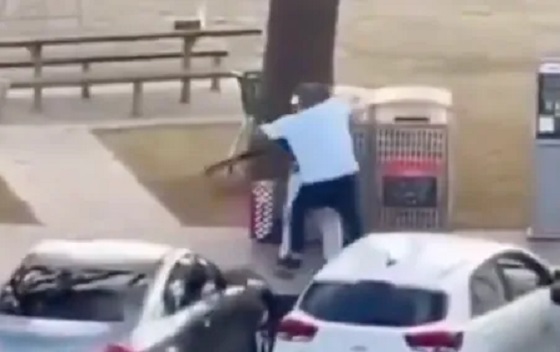Red Deer, Alberta – Recent arrests of note by Red Deer RCMP include a number of habitual offenders identified through Pinpoint, the Red Deer RCMP crime reduction strategy; more arrests took place in areas RCMP have identified as crime hot spots and locations where the public have reported active criminal behaviour. RCMP seized significant amounts of drugs, several firearms and a replica firearm during these arrests.
November 25
Shortly before 4 pm on November 25, RCMP on patrol in an area known to be active regarding stolen vehicles conducted a traffic stop and located several larger bags of methamphetamine along with a number of individually packaged smaller bags consistent with drug trafficking. RCMP seized the methamphetamine and more than $1,000 in cash as proceeds of crime.
19 year old Mackenzie Rae Bannister faces the following charges:
· CDSA 5(2) – Possession for the purpose of trafficking X 2
Bannister was remanded to appear in court in Red Deer on November 27 and will appear in court again at 9:30 am.
29 year old Robert Sean Bishop faces the following charges:
· CDSA 5(2) – Possession for the purpose of trafficking X 2
· Criminal Code 145(3) – Fail to comply with conditions
Bishop was remanded to appear in court in Red Deer on November 27 and will appear in court again at 9:30 am.
November 25
Shortly after 3:30 pm on November 25, RCMP on patrol in a known crime hot spot located a stolen truck parked at an address that police have flagged for criminal activity through the Red Deer crime reduction strategy, Pinpoint. RCMP arrested the driver without incident and seized a rifle, a shotgun and ammunition. The suspect was wanted on numerous outstanding warrants out of Red Deer at the time of his arrest.
In addition to his outstanding warrants, 33 year old Trevor James Gatzke faces the following charges:
· Criminal Code 86(1) – Unsafe storage of firearms
· Criminal Code 91(1) – Unauthorized possession of firearm
· Criminal Code 91(2) – Unauthorized possession of weapon
· Criminal Code 92(2) – Unauthorized possession of weapon while knowing possession was unauthorized
· Criminal Code 94(1) – Possession of firearm/ ammunition in vehicle X 2
· Criminal Code 355(a) – Possession of stolen property over $5,000
· Criminal Code 145(3) – Fail to comply with conditions X 3
· TSA 53(1)(b) – improper license plate on vehicle
· TSA 54(1)(a) – Drive without insurance
Gatzke was remanded for court in Red Deer on November 28 and will appear in court again on December 14 at 9:30 am.
November 25
Shortly before 7 am on November 25, RCMP responded to a report of a suspicious vehicle parked on Metcalf Avenue. RCMP confirmed the vehicle had been stolen out of Red Deer and arrested the occupant without incident. During the arrest, RCMP seized an open bottle of liquor and a pellet gun that the suspect was prohibited by the courts from possessing.
30 year old Cody Alan Feil faces the following charges:
· Criminal Code 88(1) – Possession of weapon for dangerous purpose
· Criminal Code 117.01(1) – Weapons possession contrary to order
· Criminal Code 355(b) – Possession of stolen property under $5,000 X 2
Feil also faced a number of traffic and GLA charges that have been dealt with; he is scheduled to appear in court in Red Deer on the criminal charges on November 28 at 9:30 am.
November 20
Shortly after 11 pm on November 20, RCMP on patrol in downtown Red Deer located two prolific male offenders who are well known to police in a stolen truck. During the arrest, RCMP seized cocaine and methamphetamine. The truck had been reported stolen out of Red Deer County in the early morning of November 20.
A 30 year old man faces the following charges:
· CDSA 4(1) – Possession of Schedule I substance X 2
· Criminal Code 355(a) – Possession of stolen property over $5,000 X 2
A 48 year old man faces the following charges:
· CDSA 5(2) – Possession of Schedule I substance for the purpose of trafficking X 2
· Criminal Code 145(3) – Fail to comply with conditions
Their names cannot be released at this time as the charges against them have not yet been sworn before the courts; both accused are scheduled to appear in court in Red Deer at 9:30 am on January 12, 2018.
November 20
On November 20 at 3 pm, Red Deer RCMP located a stolen Dodge Ram at a storage unit in the Kentwood neighbourhood and arrested the driver without incident. The suspect was wanted on a number of outstanding warrants at the time of his arrest. The truck had been reported stolen out of Rimbey when it was left unlocked and running.
40 year old Michael Langille faces a charge of possession of stolen property over $5,000, in addition to his warrants. He was remanded to appear in court on November 22 and is scheduled to appear again on December 6 at 9:30 am.
November 19
At 4:30 pm on November 19, RCMP responded to a report of a stolen SUV parked in a south Red Deer parking lot. On arrival, RCMP arrested a man and a woman without incident; the woman was in possession of stolen property from a store in the area at the time of her arrest. The SUV had been reported stolen out of Red Deer on November 8 after it was left with spare keys inside it. A 43 year old man and a 41 year old woman will face charges of possession of stolen property; their names cannot be released at this time as those charges have not yet been sworn before the courts.
November 18
At approximately 11:30 pm on November 18, RCMP responded to a report of a personal robbery after a man walking home through downtown Red Deer was approached by two men who assaulted him and attempted to rob him. The victim suffered minor bruising in the assault and was able to get away from the suspects. RCMP did not locate the suspects that night during patrols but identified a suspect during the course of the investigation and arrested him on November 24. At the time of his arrest, the suspect was wanted on an outstanding warrant and was found to be in possession of a small amount of methamphetamine. RCMP continue to search for the second suspect.
48 year old Bryan Wally Kersch faces the following charges:
· Criminal Code 463/344(b) – Attempted robbery
· Criminal Code 145(3) – Fail to comply with conditions X 3
· CDSA 4(1) – Possession of Schedule I substance
Kersch is scheduled to appear in court in Red Deer on December 6 at 9:30 am.
November 18
Shortly before 7:30 pm on November 18, RCMP attended a south Red Deer business in response to a report of shoplifters in custody. The suspects gave RCMP officers false names but police quickly determined their identities and found they were both wanted on numerous outstanding warrants.
33 year old Melissa Caylene White and 38 year old Travis Dwight Lindsey each faced a new charge of obstructing a peace officer (CC 129(a)) as well as their outstanding warrants. White appeared in court in Red Deer on November 20 and has since had her charges dealt with. Lindsey appeared in court in Red Deer on November 21 and is scheduled to appear again on December 5 at 9:30.
November 18
Shortly before 4 pm on November 18, Red Deer RCMP responded to a report of a stolen car that was parked in a parking lot in the Bower neighbourhood. RCMP attended and arrested the two occupants without incident. The car had been reported stolen out of Red Deer on November 15 after it was left with spare keys inside it.
47 year old Joel David Bremner faces the following charges:
· Criminal Code 355(b) – Possession of stolen property under $5,000
· Criminal Code 351(1) – Possession of break-in instruments
Bremner was remanded to appear in court in Red Deer on November 20 and is scheduled to appear again on November 28 at 9:30 am.
25 year old Christopher Evan Keizer faces the following charges:
· Criminal Code 355(b) – Possession of stolen property under $5,000
· Criminal Code 351(1) – Possession of break-in instruments
· Criminal Code 733.1(1) – Fail to comply with probation
· TSA 52(1)(a) – Drive without registration
· TSA 54(1)(a) – Drive without insurance
Keizer was scheduled to appear in court in Red Deer on November 22 at 9:30 am. He failed to appear and his charges have now gone to warrant status, along with an additional charge of failing to appear in court.
November 18
Shortly before 2 pm on November 18, Red Deer RCMP were patrolling an identified crime hot spot when they located a stolen SUV being driven by a male suspect. RCMP initiated a traffic stop and followed the SUV for some distance until it was clear the SUV was refusing to stop for police. For public safety reasons, RCMP turned off their lights and slowed down to indicate they would not pursue the suspect vehicle, which fled nonetheless and ran a red light at the intersection of Gaetz Avenue and 55 Street. Several civilian vehicles were able to avoid hitting the stolen SUV but one vehicle struck it. The stolen SUV spun and hit a traffic light then collided with another vehicle, pushing that vehicle into the vehicle behind it. RCMP arrested the driver of the stolen SUV and seized a small amount of methamphetamine from the suspect. City of Red Deer emergency services staff attended and ensured that none of the victims had been injured in the three collisions. The driver of the stolen SUV sustained minor injuries and was treated at hospital then released to police custody. The SUV had been reported stolen out of Red Deer on November 13 after it was left unattended with keys in it.
39 year old Simon John Pelletier was remanded to appear in court in Red Deer on November 24 and has since been found guilty of the following charges:
· Criminal Code 249.1(1) – Flight from police
· Criminal Code 355(a) – Possession of stolen property over $5,000
· CDSA 4(1) – Possession of Schedule I substance (methamphetamine)
November 18
Shortly after 5 am on November 18, RCMP on patrol in north Red Deer located a truck that had been reported stolen out of Red Deer late the night before. The truck was stopped at the side of the road as it had run out of gas. RCMP arrested the male driver and a female passenger without incident.
29 year old Jesse Joseph Cecka faces one charge of possession of stolen property over $5,000 (CC 355(a)). He appeared in court in Red Deer on November 20 and is scheduled to appear again on December 12 at 9:30 am.
22 year old Julianna Marie Hinz faces one charge of possession of stolen property over $5,000 (CC 355(a)). She is scheduled to appear in court in Red Deer on December 8 at 8:30 am.
November 17
Shortly after 4 pm on November 17, RCMP on patrol in an area known to be active regarding stolen vehicles located a stolen car with a license plate that had been stolen separate from the car. RCMP tracked the movement of the car from a distance until it had parked, then boxed it in and arrested the female driver without incident. The car had been reported stolen out of Red Deer on October 25 when it was left running and unattended, and the license plate had been reported stolen out of Innisfail on October 26.
A 28 year old woman faces charges of possession of stolen property over $5,000, possession of stolen property under $5,000 and a number of traffic tickets. Her name cannot be released at this time as the charges have not yet been sworn before the courts. She is scheduled to appear in court in Red Deer on December 13.
November 17
At 1 pm on November 17, RCMP on patrol in an area known to be active regarding stolen vehicles located a stolen car with two occupants. RCMP executed a high risk traffic stop and took the occupants into custody.
20 year old Savannah Lee Korth faces a charge of possession of stolen property (CC 354) and is scheduled to appear in court in Red Deer on December 4 at 8:30 am.
November 16
At 7:30 pm on November 16, RCMP responded to a report of a break-in in progress at a locked industrial compound on Golden West Avenue. RCMP attended immediately and located the suspect as he was leaving the area after being caught on camera breaking into a holiday trailer in the compound; at the time of his arrest, the suspect was found to be in breach of a number of court-ordered conditions, including a curfew.
35 year old Robert James Martin faces the following charges:
· Criminal Code 348(1)(e) – Break and enter
· Criminal Code 430(4) – Mischief under $5,000
· Criminal Code 145(3) – Fail to comply with conditions X 3
Martin was remanded to appear in court in Red Deer on November 21 and is scheduled to appear in court again on December 7 at 9:30 am.
– 30 –
Related
















